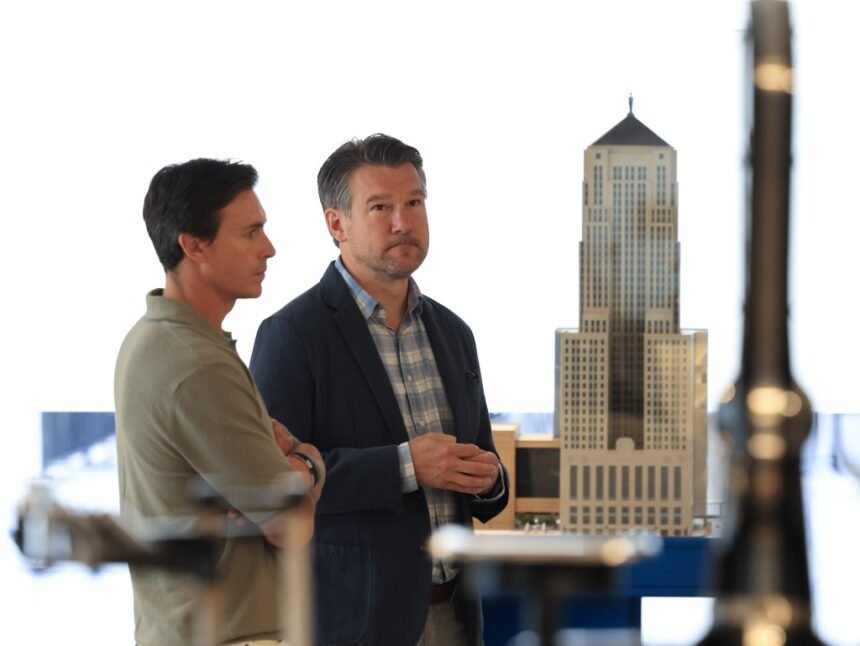A museum dedicated to preserving the legacy of open outcry trading opens Tuesday inside the Chicago Board of Trade Building, the latest step in an effort to revive the nearly century-old structure.
Much of the frantic trading activity in the building — immortalized in movies like “Ferris Bueller’s Day Off” and “The Dark Knight” — now occurs digitally, leaving its cavernous main trading floor quiet and empty. But in the Chicago Board of Trade Building Museum, architecture buffs, other visitors and the building’s many office tenants will be able to experience what it was like to be on the trading floors, and see how generations of Chicago’s leading architects created the historic landmark.
“We wanted to find a way to honor that legacy,” said Gary Stoltz, chief design and development officer of R2 Cos.
The company took over operations at the 44-story art deco skyscraper in 2023 after the previous owner, battered by the post-pandemic office market, surrendered control in late 2022 to its lender Apollo Global Management. R2 Cos. has so far spent $11 million renovating the building on the southern end of the LaSalle Street canyon at 141 W. Jackson Blvd., including the new museum and spiffing up the rooftop deck, lobbies and atriums.
Those renovations, along with other exhibits paying tribute to Chicago’s trading history, helped bring in many new tenants, making the Board of Trade one of the few buildings to thrive as the downtown office market struggles to recover.
“We’ve done about 600,000 square feet of leasing in the last two and a half years,” including about 280,000 square feet of new leases, said Matt Pistorio, a R2 Cos. partner. “I would say there are only one or two other office buildings in the city of Chicago which have done as much.”
Although nearly 30% of downtown office space is either empty or available for rent, a historic high, an increasing number of downtown office users are checking out new spaces, according to Savills, a commercial real estate firm. Most gravitate either toward the city’s new trophy properties in the West Loop or Fulton Market, or toward renovated properties where owners were willing to spend on new amenities, said Robert Sevim, Savills’ president for the Chicago region.
“The Chicago Board of Trade Building is a good example,” he said. “These buildings are the most sought after, and these are the spaces that are going to be flying off the shelves.”
Raucous trading pits, where generations of brokers shouted orders for agricultural products and other commodities, started shutting down about 10 years ago as computerized trading took over. The CME Group, a merger of the Chicago Mercantile Exchange and the Chicago Board of Trade, closed most of its open trading pits during the pandemic. But Cboe Global Markets, founded in 1973 as the Chicago Board Options Exchange, opened in 2022 a new group of trading pits on the Chicago Board of Trade Building’s seventh and eighth floors.
The building still hosts many other trading firms, Pistorio said. Total occupancy for the building is nearly 75%, and should increase soon.

“We stabilized the rent roll by doing a lot of renewals, and hope to be in the mid-80s in the next year or so,” he said.
The street-level museum includes a theater and giant screen that illustrates how the 1930 building, designed by Holabird & Root and for decades Chicago’s tallest, rose on the site of the original trading exchange. It also tracks the rise of the 1980s addition designed by noted architect Helmut Jahn, designer of the nearby James R. Thompson Center, which Google will occupy next year. Other exhibits include recorded testimonies from traders about what life was like on the trading floor, photos and a projected art display visible at night from blocks away.
“We want people to know that there is something going on at the end of the block,” Pistorio said.
Stoltz said the building already gets about 1,000 visitors every month, often school tours or others interested in the sleek art deco lobbies. And with most of the open trading pits shut down, the museum will give visitors a better sense of the building’s historic role in Chicago’s economy.
“Many people want to see the trading floor they saw in ‘Ferris Bueller,’ so we thought we could bring the energy of trading to our visitors, and show the architecture of the trading floors,” Stoltz said.

The museum was supported by a $250,000 small-business improvement grant from the city, he said. Similar grants were given in 2024 to local restaurants, all clustered around LaSalle Street and still recovering from the pandemic, including Ceres Cafe in the Chicago Board of Trade Building and Goddess and the Baker.
Stoltz said the building’s renovation is ongoing. R2 Cos. may revive the lower level, possibly transforming the massive underground vault and safety deposit boxes, where traders once stored important papers, into an event space. A long-term possibility is reopening the slanted roof’s glass-walled observation deck and visitor center, closed in the 1970s, and just below the iconic, three-story statue of Roman goddess Ceres.
“That’s going to be one of the hardest projects to pull off,” Stoltz said.
Originally Published:











